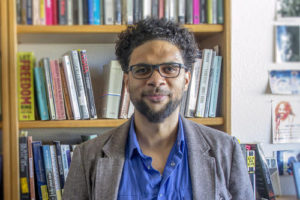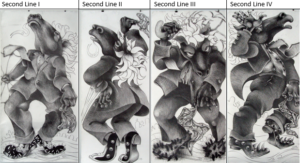The fact that the discipline of geography is classified solely as a science is one that I find to be problematic. The interactions I have had with modern geography tend more towards the hard science end of things, as physical geography especially involves a fusion of climate science, chemistry, biology, geology and more, but to classify the discipline as purely a science ignores its origins as a subject that once was more artistic than scientific in its endeavours. Continue reading “The One Where I Talk Too Much About Maps”
『G』ENESEO: The Myriad of Navigating Geneseo’s Binaries [2]
Last week, I missed INTD 288. I missed class because I went to go see the keynote speaker for the Diversity Summit. In the end, I saw the lecture and it was a sharp reminder of how binary thinking is isolating.
In particular, the dialogue, put both Steve Prince’s concept of “process” and Dennis Childs’ concept of “progress” into question. In consideration to SUNY Geneseo, it begged the question: is Geneseo making progress on their “Community Commitment to Diversity, Equity, and Inclusion”? This transformative document is made to acknowledge, reward, and hold accountable Geneseo students, staff, faculty, and administrators on their commitment to diversity. The commitment came after and in response to David Sorbello, a professor of sociology who created a transphobic quiz that gained media attention.

Continue reading “『G』ENESEO: The Myriad of Navigating Geneseo’s Binaries [2]”
Those Who Straddle the Line
In my last post, I discussed the Baby Doll maskers of the New Orleans Carnival tradition and their challenging of the Puritan notion of Providence introduced by Dr. Cope. Particularly, I focused on their collective ability to be at once child-like and suggestive, innocent and powerful, traditionally feminine and masculine. This duality is born from the Baby Dolls’ unique, signature appearance and from their audience’s misguided attempts to label, and subsequently understand, them.
Similarly, the first four pieces of Steve Prince’s Katrina Suite, entitled “Second Line I, II, III, and IV,” display a certain duality that puzzled me when I first encountered them. Each piece stars a horseman, a figure and symbol that is prominently featured in Prince’s body of work. The horsemen are clad in suits, ties, and massive, spiked shoes. Additionally, and quite conversely, three out of the four horsemen are portrayed holding a parasol, an accessory associated with the Baby Doll maskers and an arguable symbol of their femininity.
What’s Black and White, But Gray All Over?
During PSYC 307: Sensation and Perception lectures, Dr. Mounts regularly stresses that “the more you learn, the less you understand”. While Dr. Mounts refers specifically to the complexity of the human mind and brain, this idea can also be applied to human behavior and the social environment. As it turns out, this idea is also applicable to the nature of Steve Prince’s art.
I am often visually overwhelmed when studying Steve Prince’s work. Steve’s art often depicts numerous objects and figures that are clustered together to make up one chaotic composition. In an interview, Steve was asked to elaborate on why he constructs his art to be about multiple things rather than one singular thing. He explained:
“I am utilizing a design mechanism called “dense-pack” whereas I force the viewer to encounter several things all at once and they have to sift through the image like an archeologist to extract meaning and make sense of the controlled chaos. The art is meant to be viewed multiple times and meditated upon. When encountered at different cognitive points in one’s life the work has different meanings and understanding… The artwork is fixed but we are ever evolving and in a state of becoming, therefore the art is being reborn daily, and so too should we be reborn and in pursuit of a deeper understanding of self and everything around us” (.https://everybodyscoffee.com/interview-with-artist-steve-prince/ )
Continue reading “What’s Black and White, But Gray All Over?”
Providence and the Baby Dolls
Each time a supporting faculty member visits class, I am given more and more tools that allow me to better analyze both Prince’s work and the assigned class readings. Additionally, the contributions of the supporting faculty members grant me different perspectives and ideas that nearly beg to be connected with the art of Steve Prince or with the works of W.E.B. Dubois and Kim Vaz-Deville, the authors of the class’ required readings.
Dr. Cope’s lecture, in particular, not only provided me with such tools but left my mind buzzing with many thoughts and questions, as well. Specifically, I found myself considering and condemning the concept of Providence that Dr. Cope discussed throughout his lecture. I began to think about the idea, both with reference to the Puritans and their definition and manipulation of the word and its application to today’s society, as well. Since the lecture, I have been seeking connections between the Puritan, and even contemporary, idea of Providence and the Art of Steve Prince class as a whole.
The Perplexing Dove
Despite not having a guest lecturer come into class on February 18th, 2019, I called the lecture “Tools and Ingredients” in my notes. Professor McCoy wanted us to meet with a group of students to discover what we have already learned and put it into practice. Additionally, she wanted us to have stimulating conversations about the course thus far and how we can feed off of each other. Truth be told I was eager to hear other people’s thoughts and see how they have improved with the course, and possibly help me with my weak points.
Second Line Part 1

Steve Prince was not shy when declaring his christian upbringing, and thus its influence within his artwork. A common motif seen in the works we have discussed involved the figure of a horse, or multiples of them. Mr. Prince uses these horses to portray the woes of the citizens, primarily the African American ones, in New Orleans during Katrina, bringing to mind the Bible’s depictions of the apocalypse through the Four Horsemen.
A Matter of Perspective
“If you look the right way, you can see that the whole world is a garden”. ~The Secret Garden
Seeing is believing. That’s what we have been taught our entire lives; that our eyes are the one thing that is able to distinguish fact from fiction. But, what we are never told is that everyone sees differently. This goes beyond the literal sense, although it does provide the best explanation. Picture where you are now. Literally. Whether you are standing up, sitting down, or on the line at Starbucks, focus on your location and what YOU see. Now, imagine someone wants to stand in your exact spot, to see exactly what you see. Impossible isn’t it? It is physically impossible for two people to stand on the exact same spot at the exact same time, and even if the person was able to stand in your position after the fact, that person would still see different things, notice different aspects of the same surroundings. Their perspective would inevitably be different.
“As Now Printed”
I find myself to be continually intrigued by the phrase “as now printed,” found in “The Forethought” chapter of Souls of Black Folk (6). The edition we have says that this note was written at the same time as the original release of the book in 1903, indicating that DuBois anticipated that Souls of Black Folk would not only be re-released but also that the text itself would be edited. I don’t claim to know what DuBois was thinking when he added those words to the introduction to the text, but to me, it feels as though he was both reserving the right to edit and release different editions to his own work (which we know he did) and also acknowledging that future reprintings might be out of his own hands and things that he wanted to be included might not be there. This prediction has come true; for example, we don’t have the bars of music talked about in that same sentence in our edition and the most commonly released edition of Souls of Black Folk isn’t the most recently updated version but instead the first edition, which contains anti-Semitic language that DuBois later removed. Continue reading ““As Now Printed””
(GENESEO): The Myriad of Navigating Geneseo’s Binaries [1]
SUNY Geneseo was founded in 1871. In comparison to 2019 that means that the school has existed as an institution for over 148 years. In the next two years, it will be SUNY Geneseo’s 150 existing as a college that is “known for its exceptional faculty, its welcoming atmosphere, and its reputation for producing fiercely loyal alumni.” In fact, that is exactly what SUNY Geneseo is.
An exceptional institution.
Continue reading “(GENESEO): The Myriad of Navigating Geneseo’s Binaries [1]”

